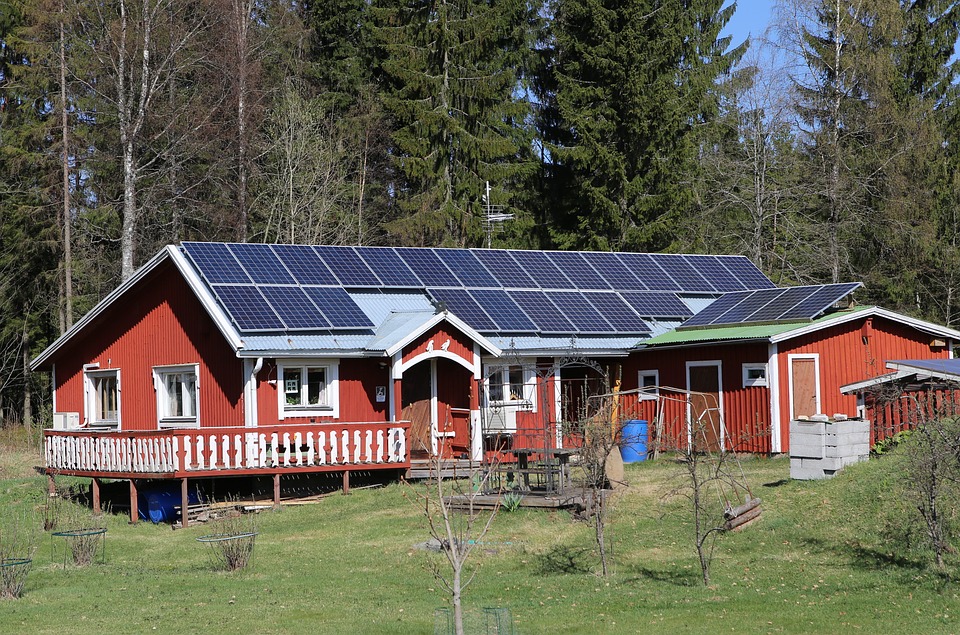How Solar Energy is Revolutionizing Architecture Design
The Rise of Solar Energy in Architecture
Solar energy has rapidly gained popularity in recent years as a sustainable and renewable energy source. Architects have started incorporating solar technologies into their designs to create energy-efficient buildings that reduce their carbon footprint. This shift towards solar energy in architecture has led to a revolution in design practices and has opened up new possibilities for innovative and environmentally-friendly buildings.
Solar Technologies in Architecture
There are several key solar technologies that architects are using to revolutionize design:
- Solar panels: Photovoltaic panels installed on roofs or facades of buildings generate electricity by converting sunlight into energy.
- Solar thermal systems: These systems use sunlight to heat water or air, providing a sustainable alternative to traditional heating and cooling systems.
- Building-integrated photovoltaics (BIPV): These solar panels are seamlessly integrated into the building’s design, serving as both a functional energy source and a design element.
Benefits of Solar Energy in Architecture
The integration of solar technologies into architecture brings numerous benefits:
- Reduced energy costs for building owners.
- Lower carbon emissions and environmental impact.
- Increased energy independence and resilience against power outages.
- Enhanced building aesthetics through innovative design solutions.
Case Studies: Solar-Powered Architectural Marvels
Several architectural projects around the world showcase the transformative power of solar energy in design:
- The Edge, Amsterdam: This sustainable office building generates more energy than it consumes, thanks to its extensive use of solar panels and other green technologies.
- Bahrain World Trade Center: The twin towers of this landmark building feature wind turbines integrated into their design to generate clean energy, complemented by solar panels.
- One Central Park, Sydney: This residential and commercial development includes a cantilevered heliostat that reflects sunlight onto the building, reducing the need for artificial lighting.
The Future of Solar Energy in Architecture
As advancements continue to be made in solar technology, the future of architecture design looks increasingly bright:
- Integration of smart building systems that optimize energy use based on real-time data.
- Development of transparent solar panels that can be used on windows and skylights to harvest solar energy without obstructing views.
- Exploration of biophilic design principles that combine solar energy with natural elements to create sustainable and healthy living spaces.
Conclusion
Solar energy is truly revolutionizing architecture design, offering architects and designers the opportunity to create sustainable, energy-efficient buildings that push the boundaries of innovation and aesthetics. By harnessing the power of the sun, architects can not only reduce the environmental impact of buildings but also improve the overall quality of life for occupants. As solar technologies continue to evolve, we can expect to see even more groundbreaking designs that blur the line between architecture and sustainability.


Pingback: How Solar Energy is Revolutionizing Architecture Design – Home Solar Sessions
cost ivermectin – order atacand 8mg online cheap carbamazepine uk
buy absorica pills – isotretinoin 20mg for sale zyvox cost
amoxicillin pill – oral ipratropium 100 mcg generic ipratropium 100 mcg
buy cheap zithromax – zithromax medication buy nebivolol cheap
order omnacortil – azipro brand prometrium canada
buy furosemide 100mg for sale – betamethasone 20gm canada3 order betamethasone creams
clavulanate tablet – order augmentin 375mg generic duloxetine 40mg oral
order vibra-tabs for sale – buy ventolin 2mg generic buy glucotrol tablets
amoxiclav drug – augmentin for sale online order duloxetine 20mg without prescription
buy tizanidine 2mg for sale – buy hydrochlorothiazide 25mg online buy generic hydrochlorothiazide over the counter
tadalafil 40mg tablet – brand name cialis sildenafil pills 25mg
viagra 100mg pills for sale – oral tadalafil 10mg cialis black
lipitor 20mg price – lipitor 80mg over the counter buy lisinopril 10mg pills
buy cenforce 50mg without prescription – metformin 500mg oral buy glucophage pill
buy omeprazole 20mg generic – buy omeprazole 10mg sale purchase tenormin pills
methylprednisolone pills – medrol 16mg over counter order aristocort 10mg online
order generic desloratadine – clarinex medication buy priligy without a prescription
cytotec for sale online – diltiazem over the counter purchase diltiazem generic
acyclovir 400mg usa – order acyclovir pills rosuvastatin 20mg us
purchase domperidone sale – cyclobenzaprine 15mg pill order cyclobenzaprine 15mg
purchase domperidone pill – domperidone 10mg pill buy generic cyclobenzaprine online
buy inderal 20mg pills – methotrexate cost order methotrexate pill
oral coumadin 5mg – maxolon brand purchase hyzaar
buy levaquin sale – oral zantac buy ranitidine 300mg
buy esomeprazole online – esomeprazole over the counter oral imitrex 25mg
order generic mobic – mobic 15mg canada order generic flomax 0.4mg
buy ondansetron without a prescription – buy zocor generic simvastatin pill
buy generic valacyclovir for sale – brand valacyclovir 1000mg buy diflucan pills for sale
Can you be more specific about the content of your article? After reading it, I still have some doubts. Hope you can help me.
purchase provigil pills purchase provigil sale buy provigil without prescription modafinil pills provigil 100mg uk modafinil 100mg uk cheap modafinil 100mg
More delight pieces like this would insinuate the web better.
Thank you for your sharing. I am worried that I lack creative ideas. It is your article that makes me full of hope. Thank you. But, I have a question, can you help me?
This is the description of serenity I enjoy reading.
zithromax online order – tinidazole pills metronidazole tablet
buy generic semaglutide online – order cyproheptadine 4mg online cheap buy cyproheptadine 4 mg
motilium over the counter – purchase sumycin purchase cyclobenzaprine pill
buy propranolol – methotrexate 5mg drug buy methotrexate paypal
amoxicillin pills – order combivent 100 mcg generic combivent order online
buy azithromycin no prescription – bystolic order online buy bystolic pill
buy augmentin 625mg generic – https://atbioinfo.com/ acillin usa
esomeprazole over the counter – anexa mate buy nexium 20mg capsules
warfarin canada – https://coumamide.com/ buy cozaar 25mg
mobic buy online – tenderness purchase meloxicam
deltasone 10mg for sale – https://apreplson.com/ order deltasone 5mg sale
online ed meds – online ed medications generic ed pills
purchase amoxil sale – combamoxi purchase amoxicillin pill
forcan pills – https://gpdifluca.com/# order fluconazole 100mg online cheap
cenforce us – order cenforce 100mg sale cenforce 100mg usa
pastillas cialis – what happens if you take 2 cialis buy cialis 20 mg online
buy cialis online usa – https://strongtadafl.com/ cialis generic best price that accepts mastercard
order generic zantac 300mg – generic zantac 150mg buy ranitidine pills
best price on viagra 100mg – where do you buy viagra buy viagra sweden
More peace pieces like this would create the интернет better. prednisolona para quГ© sirve
With thanks. Loads of erudition! buy accutane cream
I’ll certainly carry back to review more. https://ursxdol.com/furosemide-diuretic/
The thoroughness in this draft is noteworthy. https://prohnrg.com/product/lisinopril-5-mg/
More posts like this would make the blogosphere more useful. https://aranitidine.com/fr/en_ligne_kamagra/
Facts blog you have here.. It’s obdurate to find elevated calibre script like yours these days. I really comprehend individuals like you! Withstand vigilance!! https://ondactone.com/spironolactone/
Good blog you possess here.. It’s hard to find high quality belles-lettres like yours these days. I honestly recognize individuals like you! Go through guardianship!!
https://doxycyclinege.com/pro/tamsulosin/
With thanks. Loads of knowledge! https://myvisualdatabase.com/forum/profile.php?id=118014
forxiga 10mg ca – https://janozin.com/# forxiga over the counter
buy generic orlistat for sale – https://asacostat.com/# xenical order online
I’ll certainly carry back to read more. https://experthax.com/forum/member.php?action=profile&uid=124808
Your article helped me a lot, is there any more related content? Thanks!
Thank you for your sharing. I am worried that I lack creative ideas. It is your article that makes me full of hope. Thank you. But, I have a question, can you help me?
You can conserve yourself and your ancestors nearby being alert when buying medicine online. Some pharmaceutics websites function legally and provide convenience, reclusion, cost savings and safeguards as a replacement for purchasing medicines. buy in TerbinaPharmacy https://terbinafines.com/product/provera.html provera
This is a topic which is in to my callousness… Many thanks! Faithfully where can I find the phone details for questions? ou se trouve date peromption plaquette fildena
I am in truth enchant‚e ‘ to glitter at this blog posts which consists of tons of worthwhile facts, thanks representing providing such data.
I don’t think the title of your article matches the content lol. Just kidding, mainly because I had some doubts after reading the article.
https://t.me/s/Top_BestCasino/135
Can you be more specific about the content of your article? After reading it, I still have some doubts. Hope you can help me. https://accounts.binance.info/hu/register-person?ref=IQY5TET4
Had a little trouble with the utbetlogin at first, but once I figured it out, smooth sailing. Make sure you double-check your details when signing in! Otherwise, the site seems legit. utbetlogin
Envie de parier 1xbet rdc telecharger est une plateforme de paris sportifs en ligne pour la Republique democratique du Congo. Football et autres sports, paris en direct et d’avant-match, cotes, resultats et statistiques. Presentation des fonctionnalites du service.
Aus den Bonus-AGB geht hervor, dass du das erhaltene Bonusgeld aus jedem Bonuspaket 40 Mal
umsetzen musst, bevor du eine Echtgeldauszahlung beantragen kannst – alle
Gewinne aus den Freispielen müssen hingegen 30 Mal umgesetzt werden. Damit man nicht sofort
mit seinem eigenen Geld spielen muss, dürfen sich Neukunden bei diesem Anbieter auf einen tollen Willkommensbonus freuen. Diese
Codes sind interessant für Glücksspieler, weil man sich dadurch Vorteile
sichern kann, die über das Willkommensangebot hinausgehen. Verde Casino Promotionen und Verde Casino Aktionscodes sind besonders attraktiv für Spieler, da sie zusätzliches Startguthaben oder
Freispiele ermöglichen, wodurch sich die Gewinnchancen erhöhen. Partnercodes sind eine gute Möglichkeit, zusätzliche Vorteile zu
erhalten, ohne auf reguläre Aktionen warten zu müssen.
Diese Optionen fördern ein ausgewogenes Spielverhalten und minimieren potenzielle Risiken. Sobald dieser angeklickt und die Telefonnummer per SMS-Code bestätigt ist,
stehen die Freispiele ohne Einzahlung bereit. Nach dem Absenden erhalten Nutzer eine Bestätigungs-E-Mail mit Aktivierungslink.
Freispiele der ersten Stufe verteilen sich auf
Book of Ra Deluxe. Die Freispiele werden auf Joker Stoker
gutgeschrieben – ein unterhaltsamer Slot mit Jokern, Bonusrunden und potenziellen Multiplikatoren.
References:
https://online-spielhallen.de/1red-casino-erfahrungen-ein-umfassender-bericht-von-einem-erfahrenen-spieler/
Pixcassino1, saca só! Pra quem curte um cassino online com depósito rápido via Pix, esse aqui é bala. Já fiz uns saques rápidos e joguei minhas fichas sem stress. Fica a dica: pixcassino1
Нужен эвакуатор? вызов эвакуатора спб цена быстрый выезд по Санкт-Петербургу и области. Аккуратно погрузим легковое авто, кроссовер, мотоцикл. Перевозка после ДТП и поломок, помощь с запуском/колесом. Прозрачная цена, без навязываний.
Нужны заклепки? заклепка вытяжная нержавеющая для прочного соединения листового металла и профиля. Стойкость к коррозии, аккуратная головка, надежная фиксация даже при вибрациях. Подбор размеров и типа борта, быстрая отгрузка и доставка.
Узнать больше: Адреса скупки в Москве
Нужен эвакуатор? вызов эвакуатора машин быстрый выезд по Санкт-Петербургу и области. Аккуратно погрузим легковое авто, кроссовер, мотоцикл. Перевозка после ДТП и поломок, помощь с запуском/колесом. Прозрачная цена, без навязываний.